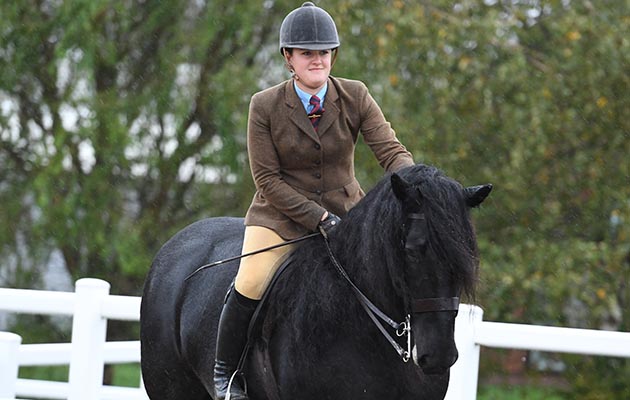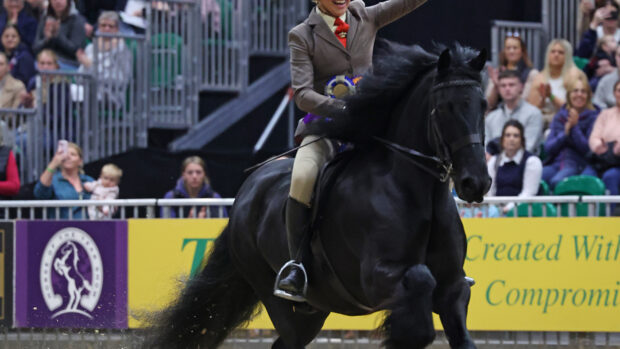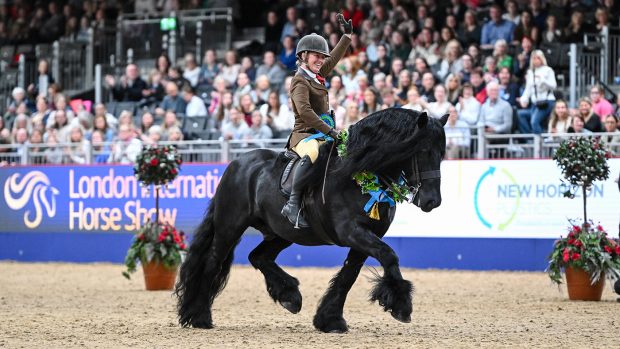The Dales pony is one of the UK’s Mountain and Moorland breeds, which, according to the Dales Pony Society (DPS) is a native of the upper dales of the eastern slopes of the Pennine range, from the High Peak in Derbyshire to the Cheviot Hills near the Scottish Border.
While there is no height limit on the Dales pony, the preferred height range stated in the breed standard is between 14hh (142.2cm) to 14.2hh (146.2cm).
Dales pony breed standard
Head: Neat and pony-like. Broad between the eyes, which should be bright and alert. Pony ears slightly incurving. Long foretop of straight hair down the face.
Neck: Strong and of ample length. Stallions should display a bold outlook with a well-arched crest. Throat and jaws clean-cut. Long, flowing mane.
Shoulders: Well-laid, long, sloping shoulders with well-developed muscles. Withers not too fine.
Body: Short-coupled and deep through the chest, with well-sprung ribs.
Hindquarters: Deep, lengthy and powerful. Second thighs well-developed and very muscular. Tail well set on, not high, with plenty of long, straight hair reaching the ground.
Hocks: Broad, Flat and clean. Well let down with plenty of dense flat bone below.
Forearms: Set square. Short and very muscular, with broad, well-developed knees.
Feet, legs and joints: The very best of feet and legs, with flexible joints, showing quality with no coarseness. The cannons should display eight to nine inch (20.3cm — 22.9cm) of flat, flinty bone and well defined tendons. Pasterns should be nicely sloping and of good length. Ample silky feather on the heels. Large, round feet open at the heels, with well developed frogs.
The Dales is defined by its flashy, energetic action. The DPS states that: “the knee and hock should be lifted and the hind legs should be flexed well under the body for powerful drive.”
The Dales can be black, brown, grey, bay or roan in colour and the DPS has clear rules on markings which can alter a pony’s status in the grading system. A white star and/or snip on the head and/or white fetlocks to the hind legs are permitted only. Mismarked ponies will be down-graded to section B. Section Bs are not allowed to be used as breeding stallions and colts which are not of section A status must be castrated.
In the Pennine range between Roman times and the mid-19th century, a lead mining industry was developed.
The DPS says that: “During the late 17th century, the Scotch Galloway was considered to be the best pony for fast pack work and replacements were bred near the lead mines. Suitable native mares ran with the breeding herds and it is recorded that farmers also liked to run a few Scotch mares with the native herds on the fell. The largest, strongest and most active ponies were chosen for pack work and were well fed to ensure fitness and speed. So it was that the black Galloways of the mixed herds eventually superseded the Scotch Galloway, and became the Dales pony.”
The influence of the Scotch Galloway has ensured the Dales pony is known for its endurance, strength and ability to work over rough country.
The DPS holds regular breed shows for the ponies and HRH Prince of Wales is patron of the society.
The Dales pony is one of three breeds known to be a carrier of the fatal genetic disease foal immunodeficiency syndrome (FIS). It was first identified in Fell ponies, and later in the Dales.
The DPS defines FIS as an inherited disease: “If a syndrome foal is born, both its parents must be carriers, as the faulty gene is recessive. The foals affected have a defective immune system and cannot resist disease properly – they die, usually within the first month or two of life. The condition is invariably fatal if usual treatments are employed. Not every foal of two carrier parents are born with the syndrome – the chance of a syndrome foal from each mating of two carrier ponies is one in four. However, other unaffected foals may well be carriers.”
All colts now must be tested clear to be eligible for licensing and have been since 2012. Mares may be carriers and the only way to know is by testing which can be done through the society.
You may also be interested in:

The Fell pony: all you need to know about this hairy native breed with flash and heart
Find out all you need to know about this versatile breed

How to buy a Dales pony, plus what to look for in a quality example of this native breed

‘What a result for the breed’: Dales stallions take top two spots in M&M supreme at London International

Subscribe to Horse & Hound magazine today – and enjoy unlimited website access all year round




